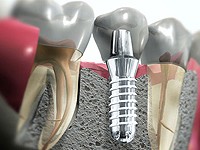Dental Abscess
When bacteria infect the nerve of the tooth, they can extend into the gums, the cheek, the throat, beneath the tongue, or even into the jaw or facial bones. A dental abscess develops and can become very painful when tissues become inflamed. As the bacteria multiply and continue to destroy tooth, bone and gum tissue, pus collects at the site of the infection and becomes progressively more painful until it either ruptures and drains on its own or is drained surgically. Sometimes the infection can progress to the point where swelling threatens to block the airway, causing difficulty breathing (Ludwig’s Angina). Dental abscesses can also make you generally ill, with nausea vomiting, fevers, chills, and sweats. In very rare occasions, it may cause abscess of the brain (from an upper tooth abscess). Even worse, there have been incidences of death from an untreated tooth abscess.
Symptoms of a Dental Abscess
Symptoms of a dental abscess typically include:- Pain
- Swollen glands of the neck
- Swelling of the gum over the infected tooth (may look like a pimple)
- Sensitivity of the teeth to hot or cold
- Redness of the mouth and face
- Bad or bitter taste
- Bad breath
- Swelling of the face or neck region (cellulitis) – a very serious symptom
- Nausea
- Vomiting
- Fever
- Chills
- Difficulty fully opening your mouth or swallowing
If you think you have an abscess you need treatment IMMEDIATELY. Call your dentist. If you cannot reach a dentist, go to a hospital’s emergency department for evaluation, especially if you feel sick.
Untreated abscesses may get worse and can lead to life-threatening complications.
Exams and Treatment for a Dental Abscess
A dentist will need to examine you and determine the cause of the abscess. Dental x-rays will help determine the source of the abscess and the extent of its damage. Prompt treatment usually cures the infection.
The treatment goal for a dental abscess is to save the tooth and cure the infection and prevent complications. Depending on the size of the abscess and the state of the tooth causing the abscess, various forms of treatment may be indicated, including root canal, incision and drainage or gingival scaling. In some cases, the abscess has caused severe bone damage around the infected tooth and the tooth may need to be pulled (extraction). Some people may need to be admitted to the hospital.









